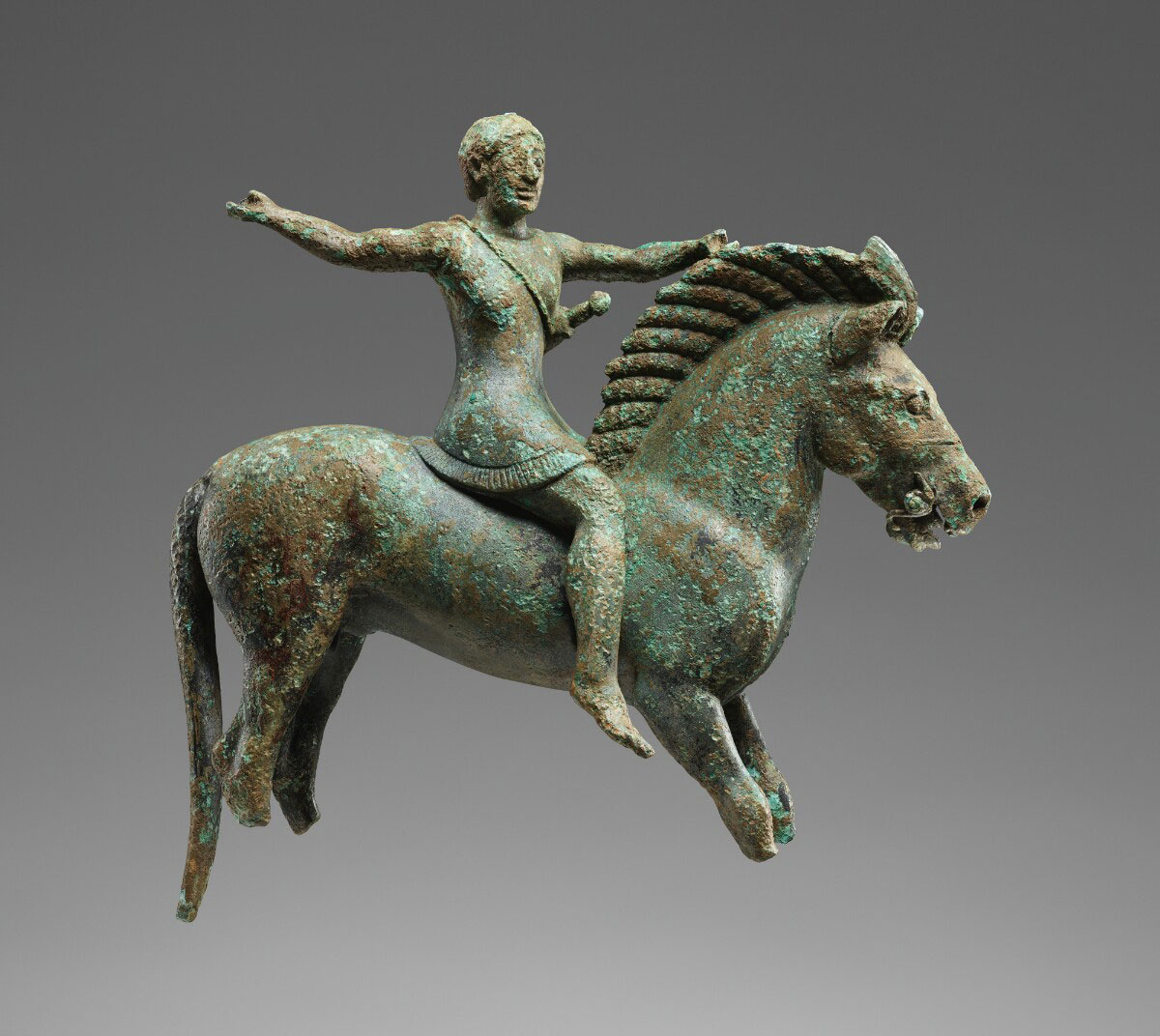At first, it was just a glint of green and brown in the dirt, exposed during routine plowing at an Albanian farm located next to an ancient Greek settlement.
Then, as archaeologists carefully cleared the soil away, its shape gradually emerged: a figure of a rider atop his horse, one arm extended as if to brandish a weapon or whip.

The horse’s hooves were lost, and much of the rider’s body was still concealed beneath layers of dirt. But the archaeologists who spotted this statuette knew it was something exceptional.
The Albanian Institute of Archaeology enlisted Getty’s help, entrusting the horseman—still caked in soil—to the Museum’s conservation lab, where conservators and researchers spent months cleaning the bronze and investigating its origins. The statuette is on view in a special exhibition, The Horse and Rider from Albania, at the Getty Villa Museum from July 26, 2023, through January 29, 2024; then, it’ll head back home.
“How did it get there, and why was it there, and why was there nothing else found around it that we could really associate with it?” said Jens Daehner, associate curator of antiquities at the Getty Museum, highlighting the questions researchers are trying to answer about this unique find. Yet, he marveled, “The Albanian piece is very much of a quality that you hardly find anywhere else in the Greek world. It’s a really special object.”

An unexpected treasure
The 2018 discovery of the Horse and Rider, as the statuette came to be known, was the result of serendipitous circumstances. During that year’s excavation campaign at the site of Babunjë—a project of several European countries—the archaeologists observed a local farmer plowing his field nearby. They figured it was worth paying close attention to, since stray finds are always a possibility. You never know what can be found near the top layers of soil. Sure enough, as the farmer plowed the field after the season’s onion harvest, the archaeologists witnessed the statuette coming up from no more than 15 inches below the surface.

Initial assessments based on the piece’s artistic techniques, how it was cast, its style, and its location in an area where ancient Greeks settled indicated that the object was Greek and dated from around 500 BCE.
Recognizing Getty’s expertise in antiquities conservation and its state-of-the-art facilities, the Albanian colleagues proposed a collaboration with Getty on the statuette’s conservation. Plans for the investigation, treatment, and eventual exhibition were made, and the statuette finally arrived in Los Angeles last year.

Removing centuries of grime
Susanne Gänsicke, senior conservator of antiquities at Getty and a specialist in the preservation of ancient metals, had her work cut out for her. The statuette came to the conservation lab with plenty of soil still attached, making it impossible to make out many details. First, the bronze was examined by X-radiography, which revealed that the horse was solid, not hollow in its center, and that the work was, impressively, cast in one piece. The imaging also showed that beneath the dirt, the rider wore a sword.
“That was a really nice surprise,” Gänsicke said.

Using a tiny scalpel made for performing eye surgery, Gänsicke began carefully picking away at the dirt. Dabs of ethanol served as a lubricant to help loosen the soil, and a tiny paintbrush helped sweep away dust. “It’s pretty similar to what we experience when we go to the dentist,” she said. The process was nerve-wracking, she admitted, because she needed to remove soil without damaging the original surface.
Eventually, her careful work began to reveal details on the statuette, like the horse’s eyes and nostrils and the rider’s smile. Further research will help determine the exact cause of the corrosion that’s turned the bronze green.

Investigating the statuette’s origins
Curators and historians from Getty and in Europe eager to learn the story behind the statuette face a big challenge: no other artifacts were found nearby. There’s no evidence—from, say, the remnants of a house or sanctuary—to provide clues about who owned the bronze and where or how it was used. And because the horse’s hooves are missing, it’s unclear if or how it was attached to something else, like a piece of furniture or a vessel.
“We can compare it to other objects of a similar nature and then come up with a couple of scenarios, but so far we cannot point to one more than another,” Daehner said. “So, it’s still an open question: was it a stand-alone piece or part of something even bigger and more impressive?”
When the statuette returns to Albania, its full history will likely still be unknown and remain a subject of research for years to come. “The conservation includes analysis that allows us to learn more about the actual metallurgy, i.e., the composition of the metal, how it was made, and where it could have been made,” Daehner said. “And the hope is that with future excavations, we will gain more data points in order to get closer to answer these questions.”

Visitors to the exhibition at the Getty Villa will see the statuette as well as videos and images documenting the conservation process. In Albania, the object will eventually go on permanent display at the National Historical Museum in Tirana.
“I think what is really special about this project is two things: One, that we get to display this extraordinary statuette for the first time here, which is a sign of these institutions trusting Getty with this high-value piece,” Daehner said. “And two, that we get to work on an object we usually don’t get to. Doing conservation treatment of something that just recently came out of the ground is a rare opportunity for us.”






